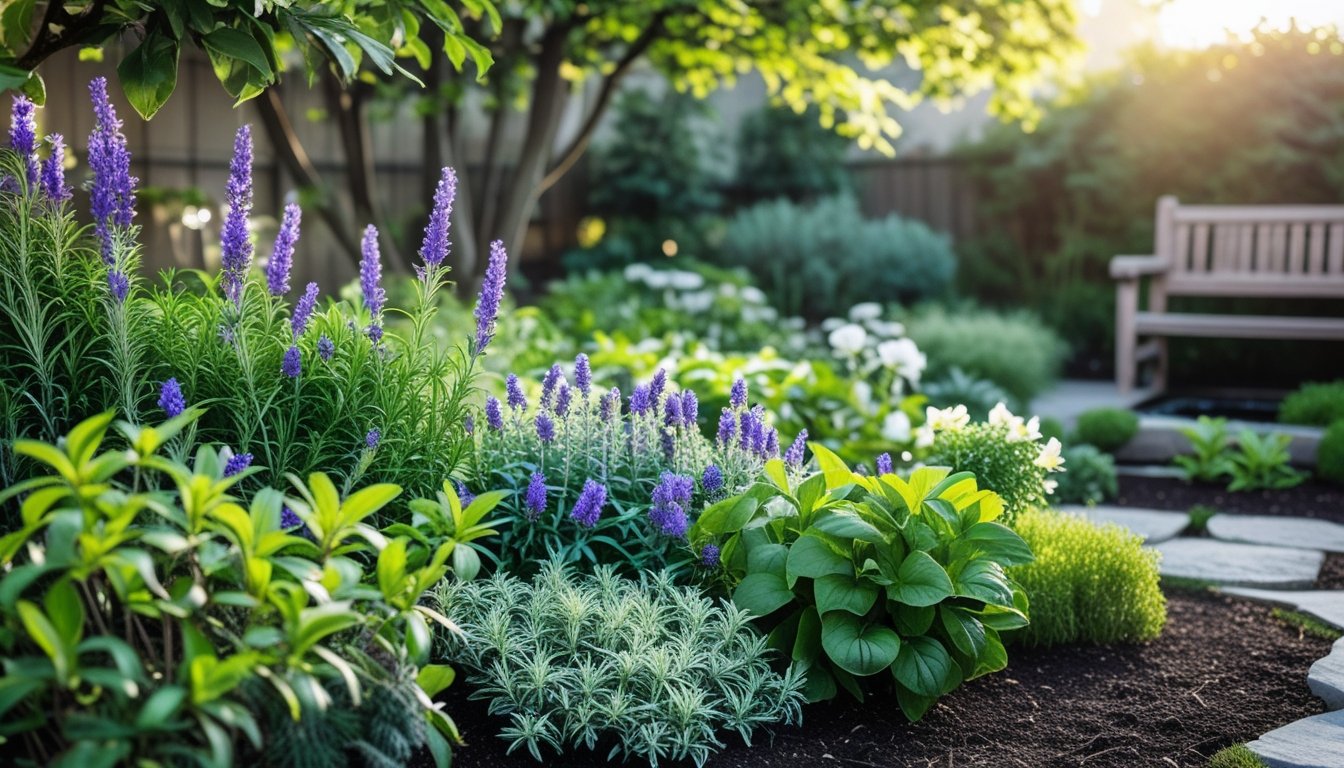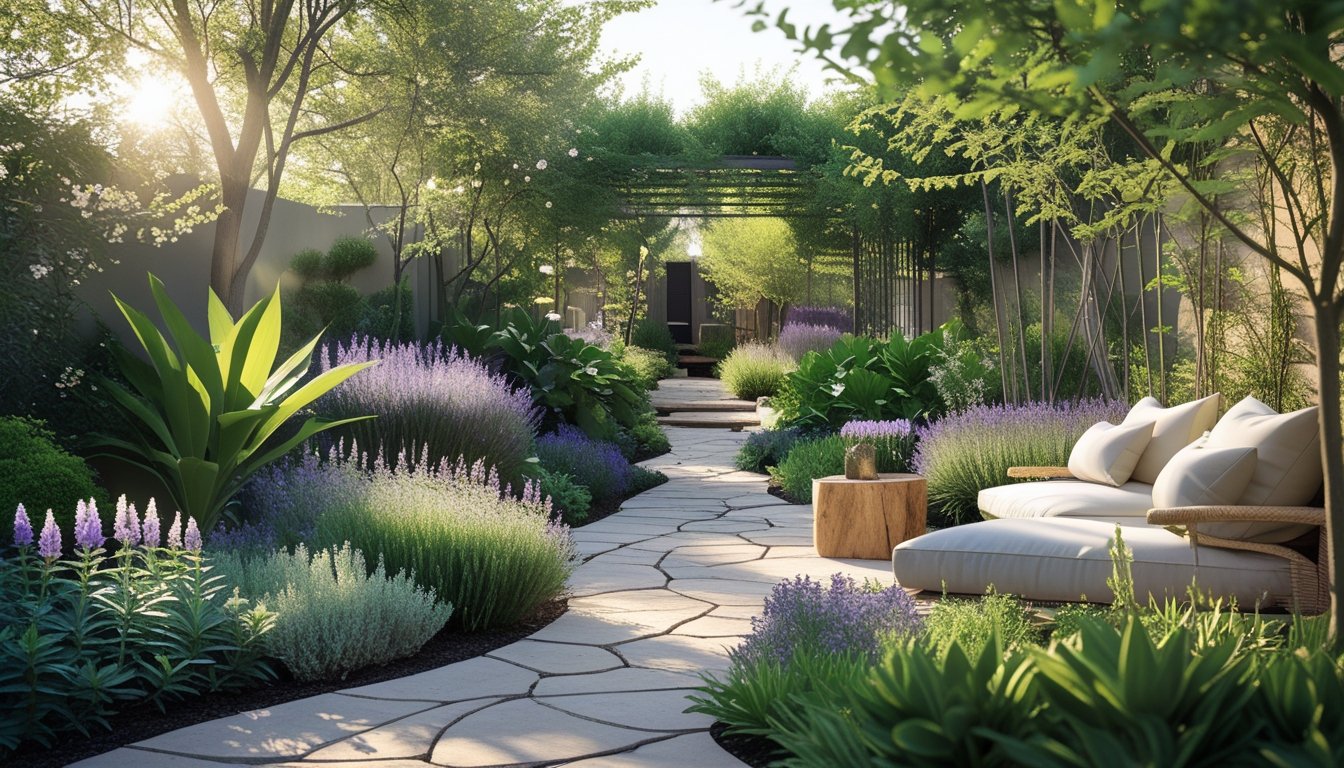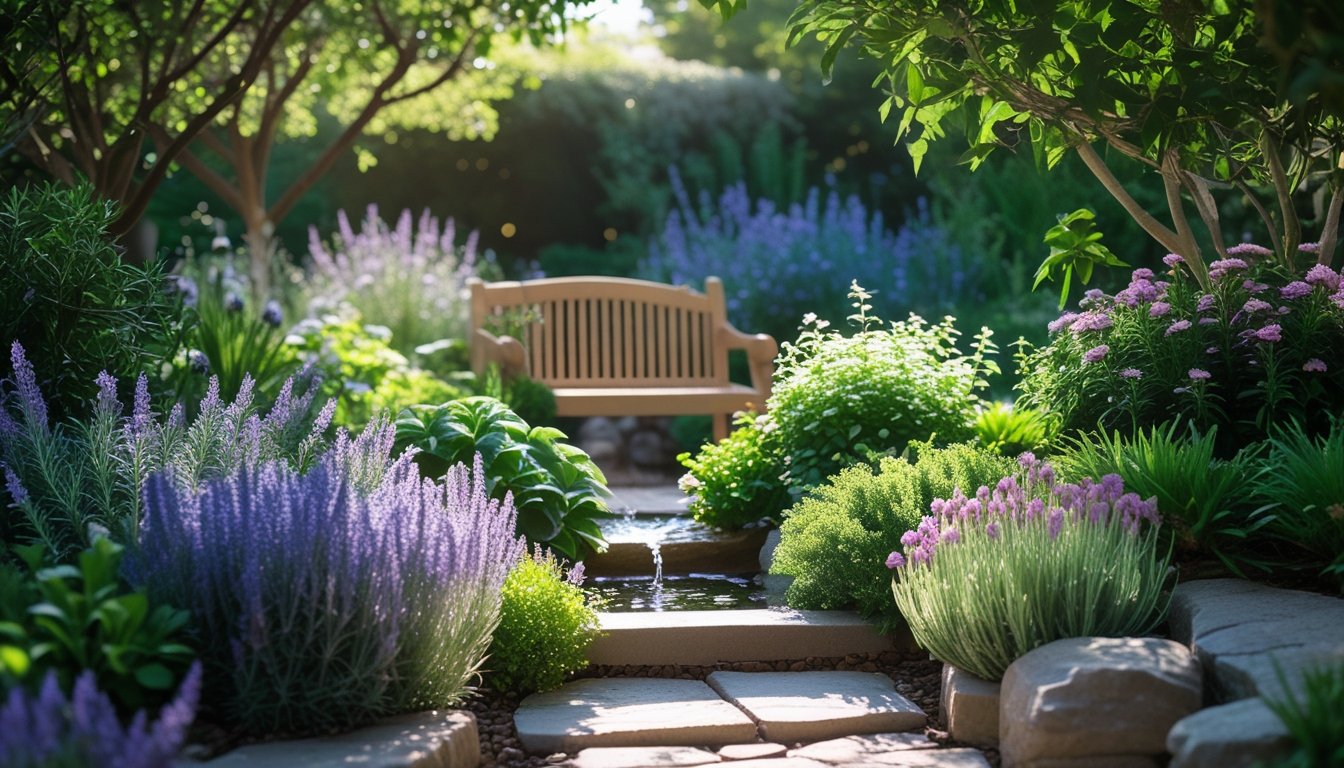Late updated: 23 Jul 2025 11:07
Written by: James Whitaker
Creating a Calming Garden Atmosphere with Scented Plants: A Guide to Serenity
Embracing the natural beauty of a garden is a timeless way to cultivate calmness and mindfulness in our outdoor spaces. By planting an array of scented plants, we can transform a typical garden into an inviting sanctuary that appeals to the senses. Incorporating fragrant flowers like lavender, chamomile, and jasmine can create a soothing aroma that envelops us in a relaxing atmosphere.

By selecting plants that thrive in our specific climate and garden space, we ensure a low-maintenance and continuously blooming garden. The varied scents from different plants not only attract beneficial pollinators but also contribute to a serene and harmonious environment. Personalising this space with features such as wind sculptures or lanterns further enhances its unique charm and therapeutic qualities.
As we explore different scent profiles and design strategies, we discover simple yet powerful ways to establish a calming garden atmosphere. Gardens should be reflections of peace and tranquillity, accessible havens for relaxation and sensory delight. Let's delve into the essential elements that make this transformation possible.
Key Takeaways
- Scented plants like lavender enhance garden tranquillity.
- Selecting with climate in mind ensures an easy-to-maintain garden.
- Personal touches personalise and enhance calming effects.
Essential Scented Plants for a Calming Garden Atmosphere
In cultivating a soothing oasis, certain aromatic plants play a pivotal role. Lavender, with its relaxing scent and purple flowers, is a timeless choice. Chamomile offers calming effects, while jasmine provides an enchanting evening aroma. Aromatic herbs like rosemary, sage, and thyme add layers of fragrance and functionality.
Lavender and Purple Blooms for Relaxation
Lavender is cherished for its soothing scent and vibrant purple blooms. This perennial is perfect for sunny, well-drained spots and attracts pollinators, infusing your garden with calming aromas. We often choose Lavandula angustifolia for its high oil content and serene fragrance, ideal for creating sachets or drying for indoor use.
The purple flowers are not only visually appealing but also encourage relaxation. Plant lavender near seating areas or pathways to enjoy its aroma as you relax outdoors. In addition, other purple-flowering plants like lilac can complement lavender, enhancing the sensory experience.
Chamomile and Its Calming Effects
Chamomile is praised for its mild, sweet scent and relaxing properties. Commonly used in teas, its gentle fragrance soothes both mind and body. We prefer planting Chamomilla recutita as it thrives in sunny spots with well-drained soil.
The plant’s small white flowers with yellow centres add visual appeal to any calming garden. A well-tended chamomile patch is not just for scent, as its dried flowers can be used for herbal remedies. Add chamomile near relaxation areas to amplify its calming aura.
Jasmine: Evening Fragrance and Serenity
Jasmine is revered for its intoxicating evening aroma. The plant’s white flowers release their fragrance at dusk, creating a tranquil environment perfect for winding down. We recommend Jasminum officinale, which thrives in sunny regions but can also adapt to partial shade.
Jasmine's vine-like growth makes it ideal for trellises or garden walls, adding structure and height. Place jasmine near outdoor living spaces to savour its scent during evening relaxation. The fragrance evokes a sense of peace, turning any garden into a serene retreat.
Aromatic Herbs: Rosemary, Sage, and Thyme
The aromatic herbs rosemary, sage, and thyme are staples in creating a fragrant garden. Rosemary, with its needle-like leaves, offers a bold pine scent and thrives in well-drained, sunny soils. It can be utilised in cooking, making gardens both fragrant and functional.
Sage's earthy aroma and vibrant leaves provide a grounding effect. It’s a hardy plant, perfect for creating depth in garden beds. Meanwhile, thyme adds a subtle, sweet scent and grows well in rock gardens or as a ground cover. Together, these herbs infuse the garden with varied scents while adding culinary value.
Design Strategies for a Sensory and Serene Outdoor Space

Utilising scented plants, ornamental grasses, and layered planting arrangements can create a sensory delight in our gardens. By carefully selecting specific elements, we can craft pathways and borders that enchant the senses, introduce calming spaces with shrubs and grasses, and leaf through the beauty of perfumed vines.
Creating Fragrant Pathways and Borders
Fragrance can transform ordinary paths into inviting passages. When designing garden pathways, we can incorporate flowers like sweet alyssum and honeysuckle, both known for their captivating scents. Lilacs, with their clusters of blooms, offer a striking visual alongside their sweet aroma.
As we edge borders, considering plants like roses and scented geraniums can enhance these spaces. Their fragrances are well-loved and can evoke feelings of nostalgia and calm. These pathways and borders not only guide guests through the garden but also enrich their experience through the powerful combination of scent and sight.
Incorporating Calming Shrubs and Ornamental Grasses
Shrubs and ornamental grasses can bring a touch of serenity with their soft movements and textures. Varieties like butterfly bush (Buddleja) not only attract pollinators with their blooms but also emit a pleasant aroma. Bee balm (Monarda) and calendula provide vibrant, aromatic additions that invite relaxation.
Including ornamental grasses such as bamboo and lamb’s ear adds texture and a gentle rustle in the breeze. These elements are invaluable in crafting areas where we can unwind and find peace amidst the subtle sounds and soothing scents they provide.
Layering Perfumed Vines and Flowering Clusters
For vertical appeal and fragrance, climbing plants are essential. Honeysuckle can drape over arbors and fences, offering a visual spectacle and a burst of perfume. Hyacinths and salvia can be planted in clusters, creating layers of flowering beauty that elevate the sensory experience.
Integrating perennials like geranium, with their long-lasting blooms, alongside herbs such as lemon balm and peppermint can complement these climbing plants, establishing a tapestry of scent. This layered approach ensures the garden remains a year-round haven, offering enchanting aromas at every corner.
Frequently Asked Questions

In a calming garden atmosphere, selecting the right fragrant plants and positioning them thoughtfully can elevate the sensory experience. Consider these specifics when cultivating a peaceful escape.
What are the best scented plants to grow for a relaxing garden ambiance?
Lavender and jasmine are top choices thanks to their soothing aromas. Their scents are known to reduce stress and improve mood, essential for a relaxing atmosphere. Rosemary and chamomile also provide calming effects and can thrive in various climates.
How can one incorporate fragrance into a garden design effectively?
Strategic placement of scented plants is key. Placing them near seating areas or paths ensures that you enjoy their aroma when passing by. Creating distinct scent zones with different fragrant plants can further enhance the olfactory experience.
Which perennial plants offer long-lasting fragrance for a garden?
Lavender and roses are excellent perennials known for their persistent fragrance. Peonies and honeysuckle also provide long-lasting scents. These plants return year after year, maintaining a consistent aromatic presence in the garden.
Are there any scented plants that also attract pollinators?
Lavender and jasmine not only smell wonderful but also attract pollinators like bees and butterflies. Rosemary and sage offer similar benefits, supporting local pollinator populations and contributing to a thriving garden ecosystem.
How can the placement of scented plants enhance the sensory experience of a garden?
Position scented plants to maximise both fragrance and beauty. Placing them at different height levels can create layers of scent. Ensure they are located in areas with adequate airflow to carry their fragrance throughout the garden.
What care considerations should be taken into account when growing fragrant plants?
Most fragrant plants require well-drained soil and adequate sunlight. Pruning helps maintain their shape and encourages new growth. Water needs vary; lavender prefers drier conditions, while jasmine requires more moisture. Consistent care ensures these plants remain healthy and aromatic.
